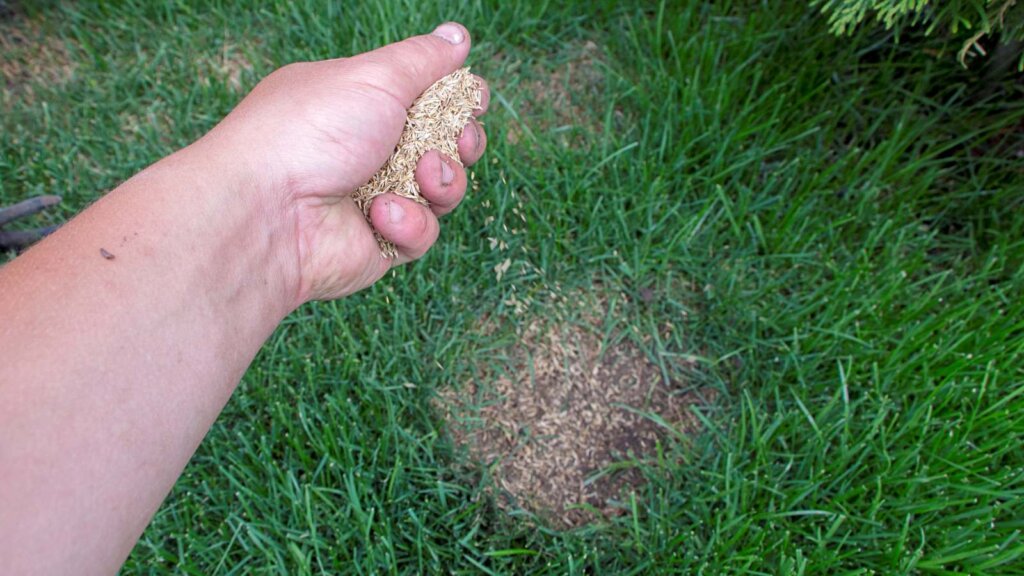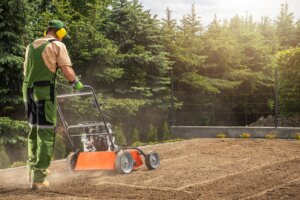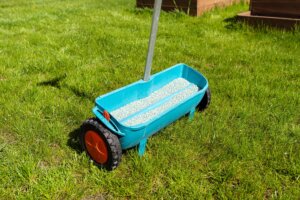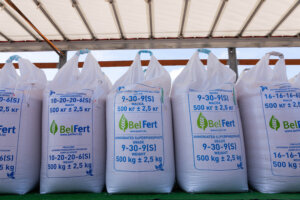Yes, you can throw grass seed on an existing lawn, but without preparation, results are often patchy and short-lived.
If you want a green lawn with healthy growth that lasts through 2025 and beyond, the overseeding process is your best bet. Overseeding means planting grass seed directly into existing grass to boost density, fill bare spots, and improve resilience.
The key?
Seed-to-soil contact, correct timing, and proper aftercare. Under ideal field conditions, you can expect up to 95% seed survival, but under less ideal conditions, you can expect about 70% survival.
Overseeding vs. Just Throwing Seeds: Why It Matters
Simply tossing grass seed onto your lawn might work in a few lucky cases, but it’s often hit-or-miss. Overseeding, on the other hand, is a proven process that blends new grass into your existing turf, fills bare spots, and boosts overall lawn health.

By preparing the soil, choosing the right seed, and ensuring proper seed-to-soil contact, you’ll get a thicker, greener lawn with much higher germination rates.
When “Just Throw Grass” Might Work (Limited Use Cases)
When “just throwing grass” works is rare, but it can be effective in certain situations, like repairing very small bare spots with loose soil and direct sunlight, or when weather and soil conditions are already ideal. Even in these cases, it’s still best to lightly rake the area and keep the soil consistently moist to prevent wasted seed.
Diagnose Your Existing Lawn (Before You Plant Grass Seed)
Before you start spreading grass seed, take a close look at your lawn’s current condition:
- Dead grass and bare spots/bare patches indicate where overseeding will have the most impact.
- Check for compacted soil on the soil surface, which can block grass roots from developing.
- Note areas with direct sunlight versus shade.
- Assess foot traffic patterns that may prevent seed germination.
- Review recent weather conditions; if the soil moisture has been inconsistent, you may need irrigation adjustments.
This evaluation will help you decide whether to overseed the entire existing lawn or target smaller areas.
Choose the Right Grass Seed (Match Grass Type to Region & Soil)
Different lawns need different seeds:
- Cool-season grasses (where cool-season grasses thrive): Kentucky bluegrass, perennial ryegrass, and fine fescue. These stay green longer in mild climates and grow best between 60–75°F.
- Warm-season grasses (common in many southern regions): Bermuda, Zoysia, St. Augustine. These flourish in 75–90°F temperatures.
Match the right grass seed to your soil type, microclimate, and established grass. Always choose high-quality seed or better seed for a resilient lawn and strong root systems.
| Grass Type | Ideal Planting Window | Germination Time (Days) | Notes |
|---|---|---|---|
| Kentucky Bluegrass | Mid-Aug to Mid-Sept | 14–21 | Slow starter but very resilient once established |
| Perennial Ryegrass | Mid-Aug to Mid-Sept | 5–10 | Quick germination, great for fast green-up |
| Fine Fescue | Mid-Aug to Mid-Sept | 7–14 | Shade-tolerant, ideal for low-traffic lawns |
| Bermuda Grass | Late April to Early June | 7–14 | Thrives in high heat and full sun |
| Zoysia Grass | Late April to Early June | 14–21 | Dense turf with good drought tolerance |
| St. Augustine Grass | Late April to Early June | 7–14 (plugs/sod) | Usually planted from sod/plugs; seed is rare |
Best Timing for Planting Grass
Timing is critical for seed germination success:
- Early fall or late summer: Best for most cool-season lawns.
- Late spring: Ideal for many warm-season grasses.
- Avoid extremes in temperature: Both cool-season and warm-season grasses germinate best under stable weather conditions.
When seeding during the ideal cool-season window of mid-August to mid-September, you can expect visible new grass in just about one week, and a first mow at three weeks. Planting at the right time supports winter color retention and helps your lawn stay green under stress.
Step-by-Step: Planting Grass (Overseeding) on an Existing Lawn
1) Mow Low
Set your mower to about 1.5–2 inches. Mow low to expose the soil surface and improve light for new seeds/new seedlings.
2) Clear Debris & Dethatch
Remove dead grass and thatch so seeds aren’t trapped above the soil. This improves direct contact between seed and soil.
3) Relieve Compaction
Aerate or use a garden fork to loosen compacted soil. Better air and water flow boosts grass roots growth.
4) Improve Seed-to-Soil Contact
Lightly rake the topsoil and add a thin layer of compost or topsoil to improve soil contact.
5) Select & Spread Seed
Select the right seed for your existing grass. Use a broadcast or drop spreader at the correct seeding rate. Target bare patches first, then cover the whole lawn to avoid uneven throw grass seed results.
6) Starter Fertilizer (Optional but Helpful)
A starter fertilizer supports healthy growth and strong root systems without damaging tender new grass.
7) Water for Germination
Keep the soil consistently moist, not soggy. Begin with light, frequent mistings and adjust watering frequency as seed germination begins.
8) Early Care & First Mow
Avoid foot traffic while seeds sprout. When the new grass reaches mowing height, mow carefully, gradually raising the height after the first cut.
9) Aftercare (Weeks 3–8)
Switch to deeper, less frequent watering to encourage deep grass roots. Spot-seed thin areas and maintain balanced nutrition.
Grass Seed Germination: How Fast Does Grass Seed Grow?
On average, grass seed germination takes 7–21 days. Growth speed depends on:
- Grass type
- Soil moisture and soil contact
- Temperature
Cool-season varieties, such as perennial ryegrass, sprout faster than Kentucky bluegrass. Keeping the soil moist and ensuring seed-to-soil contact will speed up germination.
Common Mistakes That Kill Germination
- Skipping prep (no aeration, no dethatching)
- Poor seed-to-soil contact or incorrect seeding rate
- Using the wrong grass seed for the season grasses
- Over/underwatering that harms germination rates
Results & Benefits of Overseeding (Done Right)
A proper overseeding process delivers:
- Higher germination rates from correct prep and seed-to-soil contact
- Stronger new seedlings and strong root systems for a resilient lawn
- Less weed growth thanks to a thicker lawn
- Improved soil conditions, erosion control, and better drainage
- Longer-lasting healthy lawn with improved winter color and year-round vibrancy
From Dead Grass to New Grass
While tossing grass seed over your lawn may seem easy, it often delivers patchy, short-lived results. Overseeding, however, is a proven approach to restoring thickness, color, and overall lawn health. With the right seed, proper prep, and consistent watering, you can enjoy a lush, green yard well into 2025 and beyond.
Let Terra Do the Work
Terra Lawn Care specializes in transforming patchy, dead grass into healthy, vibrant turf. Our team knows how to choose the right seed for your yard and apply it with precision so your lawn grows evenly and looks its best.
If you want results that last, let our experts handle the work for you. Contact Terra Lawn Care today for a free quote and see how professional care can transform your lawn.



